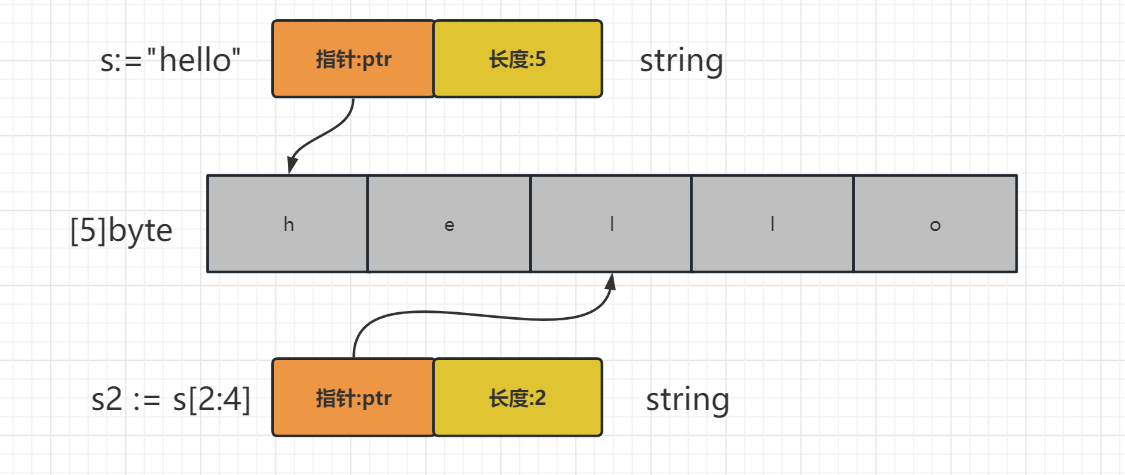[TOC]
go語言的string是一種數據類型。這個數據類型占用16字節空間,前面8字節是一個指針,指向字符串的地址。后面八個字節是一個整數,標識字符串長度
## 字符串的存儲原理

string 數據結構,源碼包 `src/runtime/string.go:stringStruct` 定義了string的數據結構:
```go
type stringStruct struct {
str unsafe.Pointer
len int
}
```
>[info]
> - stringStruct.str:字符串的首地址
> - stringStruct.len: 字符串的長度
## Unicode 轉換 utf8
```go
var s rune
s = '曾'
fmt.Printf("字符'曾'對應的Unicode的十進制: %d\n", s)
fmt.Printf("字符'曾'對應的Unicode的十六進制: %x\n", s)
fmt.Printf("字符'曾'對應的Unicode的二進制: %b\n", s)
// 運行結果:
// 字符'曾'對應的Unicode的十進制: 26366
// 字符'曾'對應的Unicode的十六進制: 66fe
// 字符'曾'對應的Unicode的二進制: 110011011111110
```
Unicode二進制轉換utf8二進制規則:`1110xxxx 10xxxxxx 10xxxxxx`
將Unicode最后六位補上utf8第三個字符的xxxxxx。將Unicode倒數7到12個字符補上utf第二個字符的xxxxxx。將Unicode剩下的數字補上utf8第一個字符(不夠前面補0)
示例如下:
'曾'對應的Unicode二進制:110011011111110
'曾'對應的utf8二進制:11100110 10011011 10111110
驗證
```go
s1 := "曾"
for i := 0; i < len(s1); i++ {
fmt.Printf("s1[%d]: %d, %b\n", i, s1[i], s1[i])
}
// 運行結果:
// s1[0]: 230, 11100110
// s1[1]: 155, 10011011
// s1[2]: 190, 10111110
```
## 字符串與字節串相互轉換
```go
// 字符串與字節串相互轉換
// (1) 字符串轉字節串,有兩種方式轉換方式。
s4 := "abc,您好"
fmt.Println([]byte(s4)) // utf8 編碼 【常用】
fmt.Println([]rune(s4)) // Unicode 編碼
// (2) 字節串轉字符串
b1 := []byte{97, 98, 99, 44, 230, 130, 168, 229, 165, 189}
b2 := []rune{97, 98, 99, 44, 24744, 22909}
fmt.Println(string(b1))
fmt.Println(string(b2))
// 運行結果:
// [97 98 99 44 230 130 168 229 165 189]
// [97 98 99 44 24744 22909]
// abc,您好
// abc,您好
```
## 統計字符串個數
```go
s5 := "abc,您好"
fmt.Printf("len: %v\n", len([]rune(s5)))
// 運行結果:
// len: 6
```
## for遍歷字符串
```go
s3 := "您好呀!abc"
for i, v := range s3 {
fmt.Println(i, string(v))
}
// 運行結果:
// 0 您
// 3 好
// 6 呀
// 9 !
// 12 a
// 13 b
// 14 c
```
- Golang簡介
- 開發環境
- Golang安裝
- 編輯器及快捷鍵
- vscode插件
- 第一個程序
- 基礎數據類型
- 變量及匿名變量
- 常量與iota
- 整型與浮點型
- 復數與布爾值
- 字符串
- 運算符
- 算術運算符
- 關系運算符
- 邏輯運算符
- 位運算符
- 賦值運算符
- 流程控制語句
- 獲取用戶輸入
- if分支語句
- for循環語句
- switch語句
- break_continue_goto語法
- 高階數據類型
- pointer指針
- array數組
- slice切片
- slice切片擴展
- map映射
- 函數
- 函數定義和調用
- 函數參數
- 函數返回值
- 作用域
- 函數形參傳遞
- 匿名函數
- 高階函數
- 閉包
- defer語句
- 內置函數
- fmt
- strconv
- strings
- time
- os
- io
- 文件操作
- 編碼
- 字符與字節
- 字符串
- 讀寫文件
- 結構體
- 類型別名和自定義類型
- 結構體聲明
- 結構體實例化
- 模擬構造函數
- 方法接收器
- 匿名字段
- 嵌套與繼承
- 序列化
- 接口
- 接口類型
- 值接收者和指針接收者
- 類型與接口對應關系
- 空接口
- 接口值
- 類型斷言
- 并發編程
- 基本概念
- goroutine
- channel
- select
- 并發安全
- 練習題
- 第三方庫
- Survey
- cobra
